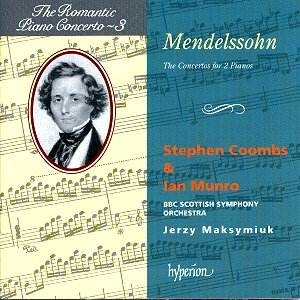A glance at the dates shows that these were teenage
works. A glance at the disc’s overall timing also shows that they are
both very substantial pieces, which is not surprising, given that the
teenage Mendelssohn was possibly the greatest child prodigy in music
history. As Julian Haylock’s typically informative note tells us, Mendelssohn’s
piano style was "derived not so much from the orchestral texturing
of Beethoven and Schubert, as from the filigree intricacies of the German
virtuoso piano school, represented principally by Weber and Hummel".
He was not so much out to push forward the boundaries of the contemporary
instrument as to exploit its best qualities – brilliant treble clarity
and the ability to sustain a flowing, cantabile line. The two
concertos on this disc exemplify these qualities admirably.
Both concertos had been dropped from the repertoire
and were entirely forgotten until, in 1950, the original manuscripts
were ‘rediscovered’ in the archive of the Berlin State Library. It seems
certain that the E major was written for the composer to play
with his sister, Fanny, who was also a gifted pianist. The A flat
could have been inspired by his first encounter with another astonishing
young piano virtuoso, Moscheles, though whether they ever played the
piece is not known. The main criticism of these Double Concertos has
been Mendelssohn’s tendency to overstretch flimsy melodic material,
an unusual amount of repetition having to take place in order for the
two soloists to have an equal share. This is true to an extent, and
virtually predictable in one so young, though his astonishing mastery
of form and structure was not too many years away. Once one accepts
the blissfully naïve, untroubled nature of the music, there is
a great deal to enjoy. Indeed, given such refreshingly direct, unmannered
and scintillating performances as here, the works emerge with astonishing
creativity and flair, clearly showing a composer on the verge of artistic
maturity. Sample the delectable 6/8 Adagio of the E major,
which anticipates Mendelssohn’s Lieder ohne Worte style, the
melody spun with seemingly unending elegance and grace. The semiquaver
pyrotechnics of the finale show the Hummel influence, but this is never
mere note-spinning – one is always aware of continuity of line and direction
of development. The first movement of the A flat, one of the
composer’s longest concerto movements (17.16), displays true internal
balance and an emerging awareness of structural proportion. The delicate,
wistful Andante foreshadows the later G minor Piano Concerto’s
slow movement, and Coombs and Munro clearly enjoy themselves enormously
in the Allegro vivace finale, where the mixture of boyish naivety
and Weber-ish high spirits is truly infectious.
Recording quality is good, with balance between the
two pianos and orchestra well realised. Support from Maksymiuk and the
BBC Scottish is excellent, with sympathetic strings and delightful wind
playing. It is good to occasionally indulge oneself in music that has
no intention of plumbing the depths, and the charm and sheer ‘likeability’
of these two pieces make them very hard to resist.
Tony Haywood


